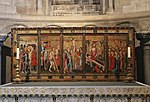Norwich Puppet Theatre

The Norwich Puppet Theatre is a nationally unique venue dedicated to puppetry housed in the medieval church of Saint James the Less a Grade 1 listed building, in the city of Norwich, England.It currently houses a 165-seat raked auditorium, a 50-seat studio, workshops, an exhibition gallery, a shop and a licensed bar. It is the only theatre in the eastern region of the UK which has a year-round programme of family-centred entertainment. It plays host to a variety of touring companies from the UK and overseas, and provides regular educational workshops for children and adults, as well as training opportunities for theatre practitioners.The theatre continues to be supported by Norfolk County Council and Norwich City Council along with contributions from foundations including: Garfield Weston Foundation, Geoffrey Watling, Norwich Town Close Estate and the John Jarrold Trust.
Excerpt from the Wikipedia article Norwich Puppet Theatre (License: CC BY-SA 3.0, Authors, Images).Norwich Puppet Theatre
Whitefriars, Norwich New Catton
Geographical coordinates (GPS) Address Phone number Website External links Nearby Places Show on map
Geographical coordinates (GPS)
| Latitude | Longitude |
|---|---|
| N 52.636 ° | E 1.3001 ° |
Address
Norwich Puppet Theatre (Saint James Pockthorpe)
Whitefriars
NR3 1TN Norwich, New Catton
England, United Kingdom
Open on Google Maps










